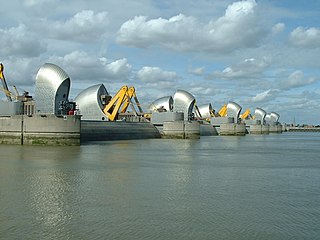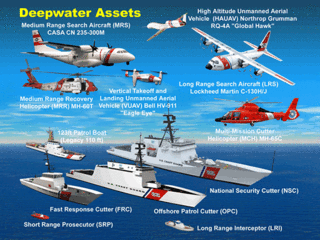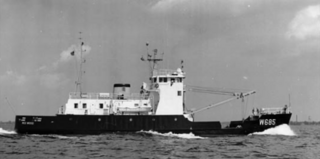Related Research Articles

Naval Submarine Base New London is the primary United States Navy East Coast submarine base, also known as the "Home of the Submarine Force." It is located in Groton, Connecticut directly across the Thames River from its namesake city of New London.

The Thames Barrier is a retractable barrier system built to protect the floodplain of most of Greater London from exceptionally high tides and storm surges moving up from the North Sea. It has been operational since 1982. When needed, it is closed (raised) during high tide; at low tide, it can be opened to restore the river's flow towards the sea. Built about 2 miles east of the Isle of Dogs, its northern bank is in Silvertown in the London Borough of Newham and its southern bank is in the New Charlton area of the Royal Borough of Greenwich.

A lightvessel, or lightship, is a ship that acts as a lighthouse. They are used in waters that are too deep or otherwise unsuitable for lighthouse construction. Although some records exist of fire beacons being placed on ships in Roman times, the first modern lightvessel was off the Nore sandbank at the mouth of the River Thames in London, England, placed there by its inventor Robert Hamblin in 1734. The type has become largely obsolete; lighthouses replaced some stations as the construction techniques for lighthouses advanced, while large, automated buoys replaced others.

USS Nautilus (SSN-571) was the world's first operational nuclear-powered submarine and the first submarine to complete a submerged transit of the North Pole on 3 August 1958. Her initial commanding officer was Eugene "Dennis" Wilkinson, a widely respected naval officer who set the stage for many of the protocols of today's Nuclear Navy of the US, and who had a storied career during military service and afterwards.

The Thames River is a short river and tidal estuary in the state of Connecticut. It flows south for 15 miles (24 km) through eastern Connecticut from the junction of the Yantic River and Shetucket River at Norwich, Connecticut, to New London and Groton, Connecticut, which flank its mouth at Long Island Sound. The Thames River watershed includes a number of smaller basins and the 80-mile (130 km) long Quinebaug River, which rises in southern Massachusetts and joins the Shetucket River about four miles northeast of Norwich.

Mayflower II is a reproduction of the 17th-century ship Mayflower, celebrated for transporting the Pilgrims to the New World in 1620. The reproduction was built in Devon, England during 1955–1956, in a collaboration between Englishman Warwick Charlton and Plimoth Patuxet, a living history museum. The work drew upon reconstructed ship blueprints held by the American museum, along with hand construction by English shipbuilders using traditional methods. Mayflower II was sailed from Plymouth, Devon on April 20, 1957, recreating the original voyage across the Atlantic Ocean, under the command of Alan Villiers. According to the ship's log, Mayflower II arrived at Plymouth on June 22; it was towed up the East River into New York City on Monday, July 1, 1957, where Villiers and crew received a ticker-tape parade. The ship was listed on the US National Register of Historic Places in 2020.

Fort Trumbull is a fort near the mouth of the Thames River on Long Island Sound in New London, Connecticut and named for Governor Jonathan Trumbull. The original fort was built in 1777, but the present fortification was built between 1839 and 1852. The site lies adjacent to the Coast Guard Station New London and is managed as the 16-acre Fort Trumbull State Park by the Connecticut Department of Energy and Environmental Protection.

Fort Griswold is a former American defensive fortification in Groton, Connecticut named after Deputy Governor Matthew Griswold. The fort played a key role in the early stages of the American Revolutionary War, in correspondence with Fort Trumbull on the opposite side of the Thames River. Griswold defended the port of New London, Connecticut, a supply center for the Continental Army and friendly port for Connecticut-based privateers who targeted British shipping. The 17-acre site is maintained as Fort Griswold Battlefield State Park by the Connecticut Department of Energy and Environmental Protection.

Havengore is a former hydrographic survey launch, originally launched in 1956 for service with the Port of London Authority (PLA). After her withdrawal from service and sale in 1995, she was re-registered as a passenger vessel for up to 40 passengers. Based on the River Thames, Havengore has also served as a ceremonial vessel. She is best known for carrying the body of Sir Winston Churchill as part of his state funeral in 1965.

Austal USA is an American shipbuilder based on Blakeley Island in Mobile, Alabama. It is a subsidiary of the Australian shipbuilder Austal, operating under a Special Security Arrangement which allows it to work independently and separately on some of the most sensitive United States defense programs despite its foreign ownership.

The United States Navy Submarine Force Library and Museum is located on the Thames River in Groton, Connecticut. It is the only submarine museum managed exclusively by the Naval History & Heritage Command division of the Navy, and this makes it a repository for many special submarine items of national significance, including USS Nautilus (SSN-571). Visitors may take a 30-minute self-guided audio tour of the Nautilus.
The United States Coast Guard Band is the premier band representing the United States Coast Guard and the Department of Homeland Security. Established in 1925, the Coast Guard Band is stationed at the U.S. Coast Guard Academy in New London, Connecticut. The Band frequently appears in Washington, D.C., at presidential and cabinet-level functions on formal and informal occasions. Once a year, it undertakes national and international tours to promote the Coast Guard.

The Heritage-class cutter, also known as the Offshore Patrol Cutter and the Maritime Security Cutter, Medium, is a cutter class of the United States Coast Guard (USCG), developed as part of the Integrated Deepwater System Program and built by Eastern Shipbuilding and Austal USA. Construction of the first vessel in the class began in January 2019. As they are completed, it is expected that they will replace 270-foot (82 m) Famous- and 210-foot (64 m) Reliance-class Medium Endurance Cutters.

USCGC Stratton (WMSL-752) is the third Legend-class cutter of the United States Coast Guard. It is the first "white hull" cutter named after a woman since the 1980s. Stratton is named for Coast Guard Captain Dorothy C. Stratton (1899–2006). Stratton served as director of the SPARS, the Coast Guard Women's Reserve during World War II.

The Integrated Deepwater System Program was the 25-year program to replace all or much of the United States Coast Guard's equipment, including aircraft, ships, and logistics and command and control systems. The $24 billion program, which began with a price tag of $17 billion, lost authorization in Fiscal Year 2012 and is officially defunct.

Royal Princess is a Royal-class cruise ship operated by Princess Cruises, a subsidiary of Carnival Corporation & plc, and is the third ship to sail for the cruise line under that name. The largest ship to have been built for Princess at the time of delivery in 2013, she became the flagship of Princess. As the lead vessel of the Royal class, she lends her name to the company's Royal class, which will consist of six ships upon the last ship's delivery in 2021. The ship measures 142,714 GT and has a capacity of 3,560 passengers.

USCGC Hamilton (WMSL-753) is the fourth Legend-class cutter, also known as the National Security Cutter (NSC), of the United States Coast Guard. She is the fifth cutter named after Founding Father Alexander Hamilton, who was the first United States Secretary of the Treasury and in that position requested the formation of the United States Coast Guard. The cutter's sponsor is Linda Kapral Papp, the wife of Coast Guard Commandant Robert J. Papp Jr.
Coast Guard Station New London is a United States Coast Guard station located in New London, Connecticut. It is a unit of Coast Guard Sector Long Island Sound and is located next to Fort Trumbull.

USCGC Red Wood (WLM-685) is a Red-class coastal buoy tender that was designed, built, owned, and operated by the United States Coast Guard. She was launched in 1964 and homeported at New London, Connecticut for most of her career. In March 1996 she moved to Philadelphia where she replaced the decommissioned USCGC Red Oak. Her primary mission while based in New London was maintaining over 200 aids to navigation from Watch Hill, Rhode Island to Execution Rocks at the west end of Long Island Sound. She also provided fuel and water to several lighthouses including the Falkner Island Lighthouse. Her secondary missions included search and rescue, light icebreaking, law enforcement, and marine environmental protection. Red Wood was initially assigned to the 3rd Coast Guard District, but was later moved to the 1st Coast Guard District when the 3rd was absorbed in a reorganization.
References
- 1 2 3 4 Woolhouse, Megan (16 August 2017). "Plan for new Coast Guard museum in Conn. gains momentum". Boston Globe. Retrieved 12 September 2017.
- ↑ Collier, David (30 March 2019). "If New London turned a corner while run by Passero, I missed it". New London Day. Retrieved 2 April 2019.
- ↑ "Commandant to officiate keel-laying ceremony for the National Coast Guard Museum". United States Coast Guard. Retrieved 19 August 2022.
- ↑ Smith, Greg (December 7, 2023). "Coast Guard highlights national museum project's oldest artifact". The Day. Retrieved 10 January 2024.